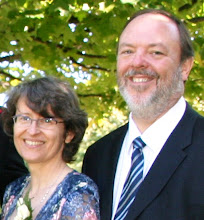During the Crusades, the Mostério was instrumental in taking this part of Iberia back from the Moorish invaders. The existing 14th century fortified church, still in good repair and in active use, is cited as an excellent example of the transition between Roman and Gothic architecture.
The two plaques read approximately as follows. Keep in mind we're just learning Portuguese!

-----------
St. John of Jerusalem
(popularly known as St. John the Baptist)
It was from Jerusalem that The Order of Hospitallers was created (also known as the Order of St. John of Jerusalem).
This Order arrived in Portugal in the 12th century, established its headquarters in Leça de Balio, and remained here until the 19th century.
From the 16th century the Superior of the Order began to call himself the "Balio", previously having been designated as the Prior of Crato or the Commander of the Order.
Between the 16th and 19th centuries the Bailo and his "Baliado" exercised almost absolute power under the Kingdom and Bishop of Porto.
-----------------------
 --------------------
--------------------The river Leça and the Monastery "Leça do Bailo"
As the oldest known document referencing the Monastery "Leça do Bailo" dates from the year 1002, its origin certainly is from the 10th century or even earlier.
By gift of Dona Teresa, later confirmed by her son Don Afonso Henriques, the Monastery was, in the 12th century, the first headquarters of the religious-military order of the Hospital which played an important part in the process of the reconquest.
The current facade of the church dates from the first half of the 14th century, being considered one of the best examples of the transition between the two architectural styles that characterized the Middle Ages: Roman and Gothic.
The Monastery possessed a vast conglomeration of properties - the "Baliagem" - which extended for several tens of kilometers. Watered by the river Leça and its tributaries, these lands over which the monastery held various types of jurisdiction were characterized by great fertility, contributing to the riches and economic power of this monastic institution.
--------------------------


Today of course, this historic building is adjacent to a factory dating no doubt from the last part of the 20th century!











